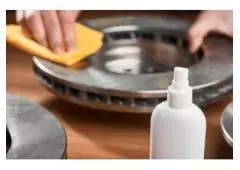Description
In the intricate world of metalworking, where precision is paramount and the smallest imperfections can lead to costly setbacks, the choice of cutting oil and its additives is of utmost importance. Among these additives, rust inhibitors stand out as indispensable components, safeguarding machinery, tools, and workpieces from the deleterious effects of corrosion. In this article, we explore the significance of rust inhibitors in cutting oil formulations, their functions, types, and the pivotal role they play in preserving the integrity of metalworking processes.
Understanding Rust Inhibitors:
Rust inhibitors, also known as corrosion inhibitors, are chemical additives formulated to protect metal surfaces from rust and corrosion. In cutting oil applications, rust inhibitors are crucial for preventing the oxidation of metal surfaces exposed to air and moisture during machining operations. These additives form a protective barrier or film on metal surfaces, preventing the formation of rust and extending the lifespan of machinery, cutting tools, and workpieces.
Functions of Rust Inhibitors:
Corrosion Prevention: The primary function of rust inhibitors is to prevent the oxidation of metal surfaces by blocking the interaction between metal ions, oxygen, and moisture. By forming a protective barrier or film on metal surfaces, rust inhibitors inhibit the formation of rust and corrosion, preserving the integrity of machinery and components.
Water Displacement: Rust inhibitors often possess water-displacing properties, allowing them to penetrate and displace moisture from metal surfaces. By removing moisture from the metal-air interface, rust inhibitors reduce the likelihood of corrosion and prolong the lifespan of metal components exposed to humid or wet environments.
Surface Passivation: Some rust inhibitors chemically react with metal surfaces to form a passive oxide layer that acts as a protective barrier against corrosion. This process, known as passivation, enhances the corrosion resistance of metal surfaces, particularly in harsh or corrosive environments.
Compatibility with Lubricants: Rust inhibitors are formulated to be compatible with cutting oils and other lubricants used in metalworking applications. They do not interfere with the lubricating properties of cutting oils but instead complement their functionality by providing corrosion protection.
Types of Rust Inhibitors:
Contact Inhibitors: Contact inhibitors form a physical barrier or film on metal surfaces, preventing the interaction between metal ions and corrosive agents. These inhibitors are commonly used in cutting oils for short-term corrosion protection during machining and storage.
Volatile Inhibitors: Volatile inhibitors release vapor-phase corrosion inhibitors (VCI) into the surrounding atmosphere, forming a protective layer on metal surfaces. These inhibitors are effective for long-term corrosion protection in enclosed environments or during transportation and storage.
Chemical Inhibitors: Chemical inhibitors chemically react with metal surfaces to form passive oxide layers that inhibit corrosion. These inhibitors are often used in aggressive or corrosive environments where conventional rust inhibitors may be less effective.
Multimetal Inhibitors: Multimetal inhibitors are formulated to provide corrosion protection for a wide range of metal substrates, including ferrous and non-ferrous metals. These inhibitors offer versatility and are suitable for use in diverse metalworking applications.
Benefits of Rust Inhibitors:
Extended Equipment Lifespan: Rust inhibitors protect machinery, cutting tools, and workpieces from corrosion, prolonging their operational lifespan and reducing maintenance costs.
Improved Surface Finish: By preventing rust and corrosion, rust inhibitors help maintain the integrity of metal surfaces, resulting in smoother surface finishes and higher product quality.
Enhanced Operational Efficiency: Corrosion-free machinery and components experience fewer breakdowns and disruptions, leading to increased productivity and efficiency in metalworking processes.
Cost Savings: By minimizing the need for premature equipment replacement and repair, rust inhibitors contribute to cost savings and improved profitability for metalworking operations.
Conclusion:
Rust inhibitors play a pivotal role in the preservation of precision and integrity in metalworking operations, offering essential protection against the corrosive effects of rust and oxidation. By carefully selecting and incorporating the appropriate rust inhibitors into cutting oil formulations, manufacturers can ensure the longevity and reliability of machinery, tools, and workpieces. In the dynamic landscape of metalworking, rust inhibitors continue to serve as indispensable guardians, safeguarding the integrity and efficiency of metalworking processes.
Keywords: Lubricity Improver, Rust Inhibitor, Extreme Pressure Additives, Semi Synthetic Cutting Oil Additives, Anti Wear Additives, Metal Working Additives, Cutting Oil Additives, Eco Friendly Cutting Oil, Bounday Layer Lubricants, Additives for Synthetic MWF, Corrosion Inhibitor, Eco Friendly Metal Working Fluid, Just Add & Sell, Lubricity additive, Lubricity enhancer, Lubricity improver for metalworking fluids, Cutting oil lubricity improver, Lubricity Improver for coolant, Lubricity Improver, Lubricity Enhancer, Lubricity Additives, Lubricity Agent, Lubricity Improver for cutting oil, Lubricity Improver for metal working fluid, Lubricity Agent for cutting oil, Lubricity Agent for metal working fluid, Lubricity Agent for soluble oil, Lubricity agent for water based cutting oil, Cutting oil additive rust inhibitor, Rust inhibitor additive for metalworking fluids, Rust inhibitor additive for cutting oils, Rust inhibitor additive for water-soluble cutting oils, Water-soluble cutting oil additive rust inhibitor, Metalworking fluid extreme pressure additive, Cutting oil extreme pressure additive, EP additive for metalworking fluids, EP additive for cutting oils, Extreme pressure additive for metalworking fluids, Extreme pressure additive for cutting oils, Water-soluble cutting oil extreme pressure additive, EP additive for water-soluble cutting oils, Extreme pressure additive for water-soluble cutting oils, Anti-wear additives for metal working fluids, Anti-wear additives for water-based cutting oils, Anti-wear additives for soluble cutting oils, Anti-wear additives for water soluble cutting oils, Anti-wear additive for soluble cutting oil, Anti Wear Additive, Anti Wear Additive for metalworking fluids, Anti Wear Additive for cutting oils, Anti Wear Additive for coolant, Anti Wear Improver, Anti Wear Agent, Anti Wear Improver for cutting oil, Anti Wear Improver for metal working fluid, Anti Wear Agent for cutting oil, Anti Wear Agent for metal working fluid, Anti Wear Enhancer, Anti Wear Agent for soluble oil, Anti Wear agent for water based cutting oil, Metalworking fluid corrosion inhibitor, Cutting oil corrosion inhibitor, Water-soluble cutting oil corrosion inhibitor, Grinding fluid corrosion inhibitor, Corrosion inhibitor additive for metalworking fluids, Corrosion inhibitor additive for cutting oils, Corrosion inhibitor additive for water-soluble cutting oils, Cutting oil packages, Cutting oil emulsifiers, Cutting oil biocides, Cutting oil friction reducer, Cutting oil mist controllers, Cutting oil PH buffers, Component of cutting oil, Ingredients of cutting oil, Chemicals used in cutting oil, Eco-friendly cutting oil, Green cutting oil, Sustainable cutting oil, Environmentally friendly cutting oil, Biodegradable cutting oil, Green metalworking fluid, Sustainable metalworking fluid, Biodegradable metalworking fluid, Metal working additives, Additives for metal working, Metal working fluid additives, Metal working oil additives, Metal cutting oil additives, Metal forming additives, Metal grinding additives, Metal machining additives, Metalworking fluid additive rust inhibitor, Additive for Semi Synthetic Cutting oil, Semi Synthetic Cutting Oil additive, Additive for Synthetic Cutting oil, Synthetic cutting oil additive, Water-based cutting oil additives, Additives for water-based cutting oils, Additives for soluble cutting oil, Water soluble cutting oil additives, Additive for soluble cutting oil, Soluble cutting oil additives, Soluble cutting oil additive, Synthetic cutting oil formula, Formula of synthetic metal working fluid, Formulation of synthetic metal working fluids, What is synthetic metal working fluid, How to make semi synthetic cutting oil, How to make synthetic cutting oil, How to make synthetic metal working fluid, Friction Modifiers, Metal working additives, Formulations of metal working fluid, How to make metal working fluids, Metal Working Fluids Additives, Additives for metal working, Formula of synthetic metal working fluid, Formulation of synthetic metal working fluids, Synthetic cutting oil formulation, What is synthetic metal working fluid, How to make semi synthetic cutting oil, How to make synthetic cutting oil, How to make synthetic metal working fluid, Metal working additives, Formulations of metal working fluid, How to make metal working fluids, Metal Working Fluids Additives, How to make cutting oil, How to make cutting oil, Cutting fluid additives, Cutting oil formulations, Chemicals used in making cutting oil, Cutting oil formula, Formula of cutting oil, Additives required for making cutting oil, Cutting oil additive, Cutting oil formulation, Cutting oil package, Additive for Synthetic Metal Working Fluids, Synthetic metal working fluids Additive, Synthetic cutting oil additives, Additives for synthetic cutting oils, Additives for synthetic coolants,Synthetic MWF additives, Synthetic ester metalworking fluid, Low cost cutting oil, How to make cutting oil, Formulations of cutting oils, Chemicals used in cutting oil, Formulation of soluble cutting oil, Formulations of meta working fluids, Formulations of metal working fluids, How metal working fluids manufacturers, Contains of metal working fluid, Contains of cutting oil, Low cost metal working fluid, Economical cutting oil, Low price cutting oil, How to make cutting oil in home, Chemicals used in making cutting oil, Cutting oil package, Soluble cutting oil package, Eco friendly cutting oil, Green cutting oil, Eco metal working fluid 100, Eco friendly metal working fluid, Ester based metal working fluids, Vegetable oil based cutting oil, Biodegradable cutting oil, Vegetable-based cutting oil, Synthetic ester cutting oil, Biodegradable metalworking fluids, Vegetable-based metalworking fluids, Mineral oil free metal working fluids, Mineral oil free cutting oils, Amine free metal working fluids, Amine free rust inhibitor, Amine free corrosion inhibitor, Chlorinated paraffin free metal working fluids, Amine free cutting oils, Biodegradable metalworking fluids, Vegetable-based metalworking fluids, Synthetic ester metalworking fluids




















